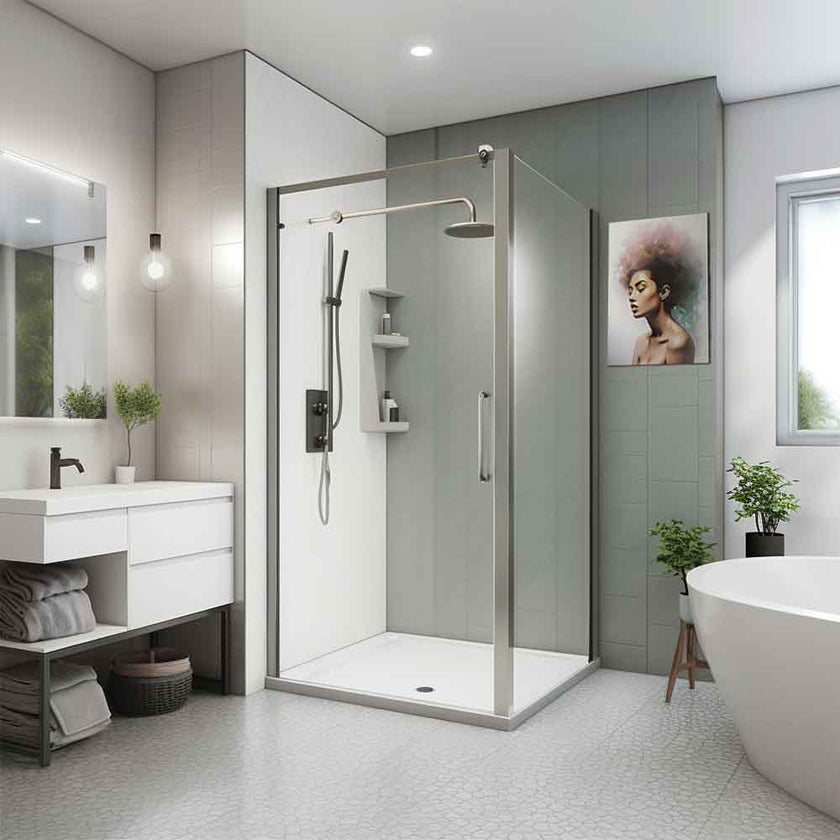Can You Put a Canvas in the Bathroom?

Can You Put a Canvas in the Bathroom?
Yes... but it isn't recommended
While it is technically possible to put a canvas in the bathroom, it is not recommended due to the high humidity and moisture levels that can damage the artwork. Bathrooms are also prone to harbor various bacteria, posing a risk to your canvas. For this reason, it's best to choose a more suitable option like acrylic prints, which are water-resistant and UV-resistant, providing better protection in a bathroom setting.
Why Acrylic Prints are a Better Choice for Bathrooms
Acrylic prints are a superior choice for bathroom art due to their resistance to water, UV light, and moisture. They offer a sharper, brighter image compared to canvas prints and boast a professional appearance. The slightly higher cost of acrylic prints is justified by their durability and overall quality, making them an excellent investment for bathroom wall art.
Alternative Art Options for Humid Bathrooms
Besides acrylic prints, you can also consider hanging houseplants or metal prints in your bathroom. Houseplants like spider plants thrive in humid environments and can improve air quality, while metal prints are durable and resistant to humidity. Just make sure to protect metal prints with water repellent varnish or oil/wax products to prevent damage.
Proper Placement for Artwork in Bathrooms
When hanging artwork in your bathroom, it is crucial to consider factors like height and sunlight exposure. Ideally, pictures should be hung at a height of 60 to 66 inches above the floor and positioned to avoid direct sunlight. Additionally, choose water-resistant materials for your artwork, and consider using eclectic collages to enhance the visual appeal.
Protecting Paintings from Humidity
To protect your paintings from humidity, varnish them or hang them away from the source of humidity. Ensure there is a gap between the back of the canvas and the wall to prevent moisture buildup. However, avoid varnishing a canvas painting unless it has a protective layer to prevent damage.
The Impact of Humidity on Acrylic Paintings
Although acrylic paintings are generally more resistant to humidity than other types of artwork, high humidity levels can still cause damage, such as warping, discoloration, and mold growth. To prevent such issues, store your acrylic paintings in a cool, dry room and use acid-free material for wrapping them.
The Harmful Effects of Humidity on Paintings
Fluctuating humidity levels can damage paintings by causing cracks, flaking, and color fading. It can also affect the drying process of the paint, leading to further complications. To protect your paintings, store them in a cool, dry room and use a humidifier to control the humidity levels in your home.
Choosing the Right Artwork for Your Bathroom
In conclusion, while it is possible to place a canvas in your bathroom, it is not the most suitable option due to the potential for damage caused by high humidity and moisture levels. Acrylic prints emerge as a superior choice, as they are water-resistant, UV-resistant, and offer a professional appearance that enhances the visual appeal of your bathroom. Other alternatives to consider include metal prints and houseplants that thrive in humid environments, such as spider plants.
When it comes to hanging artwork in your bathroom, it's important to consider the placement and material of your artwork. Aim to hang pictures at a height of 60 to 66 inches above the floor and avoid direct sunlight exposure to prevent damage. Additionally, choose water-resistant materials and ensure there is a gap between the back of the canvas and the wall to prevent moisture buildup.
Although acrylic paintings are more resistant to humidity than other types of artwork, it's still essential to protect them from damage caused by high humidity levels. Store your paintings in a cool, dry room and wrap them in acid-free material. Using a humidifier to control humidity levels in your home can also help protect your artwork from potential harm.
Ultimately, the key to choosing the right artwork for your bathroom is to consider the specific challenges presented by the environment and select materials and formats that are best suited to withstand those conditions. By carefully considering your options and taking the necessary precautions, you can transform your bathroom into a visually appealing space that showcases your chosen artwork without sacrificing its longevity.
Leave A Reply
Your email address will not be published. Required fields are marked *






